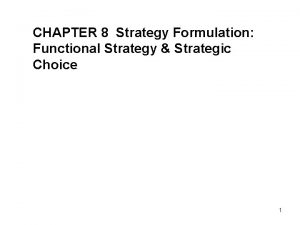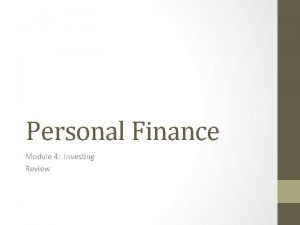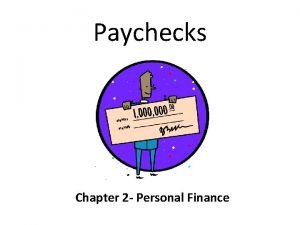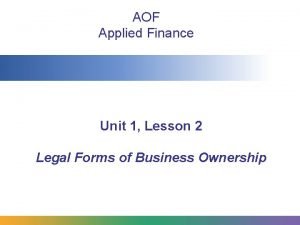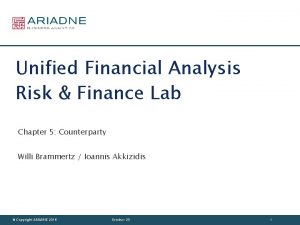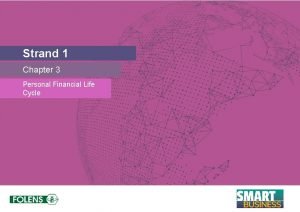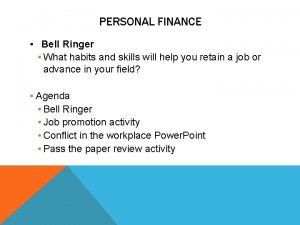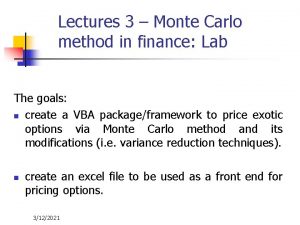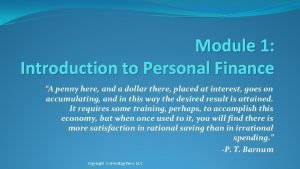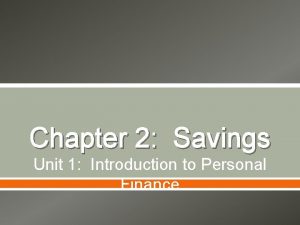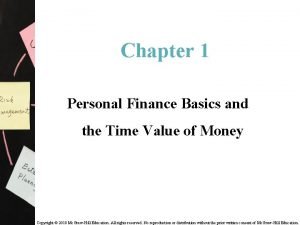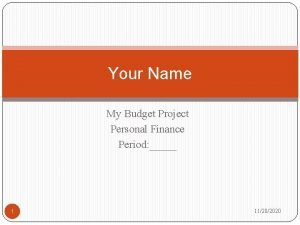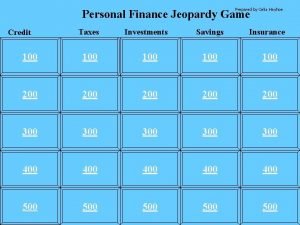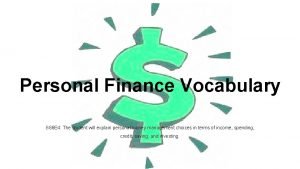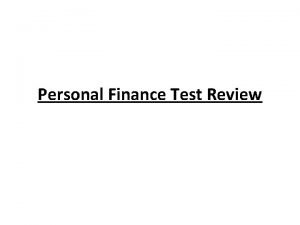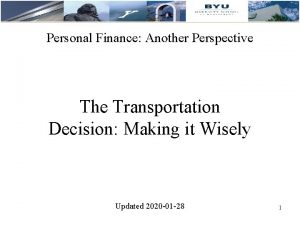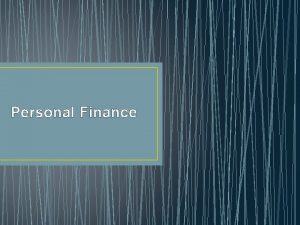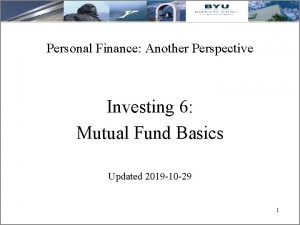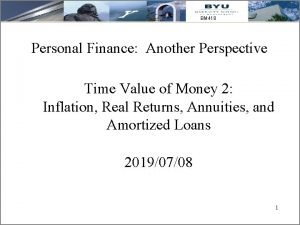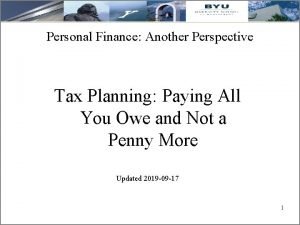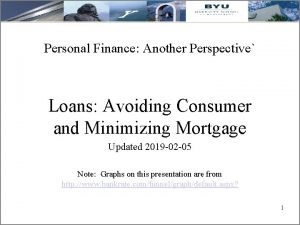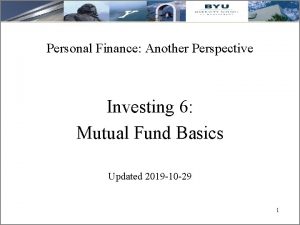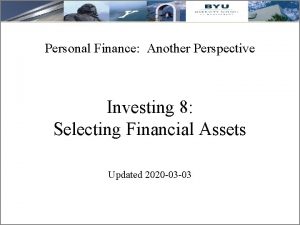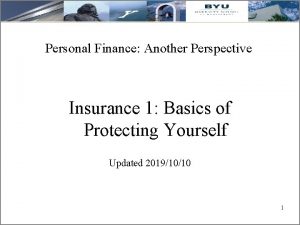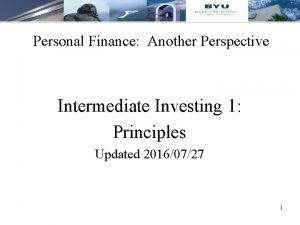Personal Finance Another Perspective The Home Decision 2


















































- Slides: 50

Personal Finance: Another Perspective The Home Decision 2 Comparing Loans and Creating your Housing Plan Updated 2020 -05 -27 1

Objectives Day 11 (Home Decision 2) • A. Understand your options in the housing decision • B. Understand how to compare different mortgage loans • C. Understand create your Housing Plan (Home Decision 3) Answer questions relating to the Housing Decision

Your Personal Financial Plan (optional) • Section XVIII: Your Home Decision Plan • What is your vision and goals for your housing plan? (use template (Education, Mission, Home Auto Template LT 01 -15) • Where do you currently live? • What expenses are you paying, including rent, mortgage, utilities, gas, repair and insurance? • What are your home plans and strategies? • This may include how often you will move, down payment strategy, negotiation strategies, strategies for warranties, etc. • What are your constraints and accountability?

Case Study • Data • Jen and Trent are looking to buy a home. Trent estimates that they will be in the home for 12 years. They have the choice between the two $200, 000 fixed rate loans, amortized over 30 years, but which will be paid back in 12 years. Loan A is for 4. 0% with no points or fees, and loan B is for 3. 75% with $1, 500 loan fee and 1 point. Calculate the EIR for both loans with prepayments • Application • Which loan is more advantageous to Jen and Trent using the EIR as a measure of their best loan? • Note: Home Loan Comparison (LT 19) may be helpful

A. Understand Options in the Housing Decision • What are your options in the housing decision? • Generally, key options relate to: • Renting • Buying • Building • Renovating • Other • Key is to understand their advantages and disadvantages

Renting • Advantages • High mobility and can move with minimal costs, no repairs and maintenance, minimal financial commitment, lower initial costs, lower monthly costs, and easier budgeting • Disadvantages • Lack of permanence and pride of ownership, rents may increase unexpectedly, possible restrictions, no tax benefits, no potential for property appreciation, and no equity buildup

Buying • Advantages • Permanence and pride of ownership, get what you see, tax benefits, generally a fixed monthly mortgage payment, leverage, can build equity and can borrow against it, minimal time commitment relative to building, mature landscaping and neighborhood, few surprises in terms of neighborhood, schools, shopping, etc. , may be able to negotiate a favorable price and terms • Disadvantages • Low mobility and low liquidity so difficult to sell if needed, significant upfront costs, higher living expenses, large financial commitment, possible decrease in value, and possible mortgage default

Building • Advantages • Can build exactly what you want, sometimes cheaper to build than buy, have all new appliances and housing systems, can pick the location and style • Disadvantages • Interpreting building plans (size of rooms, etc. ) can cause difficulty, often over budget and delays, unanticipated additional expense for yard and fencing, combined construction loan interest and rental expense can be high, high monitoring costs!!!, high stress!!!, and high risk!!

Renovating • Advantages • May be faster than building, can see what you want, may be cheaper to buy and renovate than build, and there may not be available lots in a desired area • Disadvantages • May be more expensive than to build it new, often over budget and delays, large unanticipated additional expenses for yard and fencing depending on what was renovated, combined construction loan interest and rental expense can be high, may have other major problems noted before, high monitoring costs!!! high stress and high risk!!

Other Options • Other options include: • Mobile homes, tiny houses, recreational vehicles • Advantages • Lower cost • Disadvantages • Lower resale value, lack of permanence, challenge getting finances, difficulty in building equity

Questions • Any questions about housing options and the principles of home ownership? • Rent versus buy calculators • New York Times

B. How to Compare Different Mortgage Loans • What factors go into choosing a loan? • You have lots of options for your mortgage • Fixed rate, adjustable rate, fixed with interest only and variable with interest only option • What factors do into your choice of mortgage? • Time horizon • Risk tolerance • Cash flow preferences • Goals • See Choosing a Mortgage Loan (LT 35)


Comparing Loans (continued) • How do you compare different mortgage loans? • Remember, the cost of a mortgage loan is based on points, up-front costs and expenses, escrow costs, principle and interest costs, property taxes and property insurance and PMI • Understand these costs and you can calculate a comparable rate on loans with different points, fee structures and up-front fees

Comparing Loans (continued) • Lenders will give you not one loan, but many different choices on interest rates and points • Your challenge is to minimize your effective cost of borrowing and get the least expensive loan • Remember, the broker retains the amount attributed to points when distributing the loan proceeds; however, the monthly payment will be based on the entire loan amount

Comparing Loans (continued) • What are points? • 1% or one hundred basis points of the loan • Lenders charge points to: • To recover costs associated with lending. • To increase the effective interest rate • To provide for negotiating flexibility (in a market where interest rates fluctuate), or • To adjust for differences in risk between loans • Note that origination points are not tax deductible (line 801), but discount points are all tax deductible in the year of the purchase

Comparing Loans (continued) • What is a Loan Estimate (LE)? • It is a 3 -page form received from a mortgage lender or broker after applying for a loan which includes an itemized list of all up-front fees and costs associated with your loan. • Fees include loan fees, fees paid in advance, reserves (escrow), title charges, government charges, and additional charges. • You do not have to have a signed purchase contract to apply for a mortgage loan and receive a LE • You will use it to compare different offers or quotes from different lenders and brokers • What does a Loan Estimate form look like?

• Loan Estimate – Page 1 It includes information on: • Loan terms: • Amount • Interest rate • Prepayment penalty • Balloon payment • Projected payments • Principal and insurance • Mortgage insurance • Estimate escrow, taxes, insurance and assessments • Costs at closing • Estimated cash to close

• Loan Estimate – Page 2 • • It includes information on: Loan costs including: • Origination charges (points) • Application fees • Underwriting fees Service you cannot shop for • Appraisal fee • Credit report fee • Tax monitoring fee Services you can shop for • Pest inspection fee • Survey fees • Title fees Total closing costs • Cash to close

• Loan Estimate – Page 3 It includes information on: • Comparisons • In 5 years • Annual percentage rate • Total interest percentage • Other considerations • Appraisal • Assumption • Homeowner’s insurance • Late payment • Refinancing and Servicing • Confirm receipt • This confirms you have received this, not that you must take the loan

Comparing Loans (continued) • What is the difference between the Annual Percentage Rate (APR) and the Effective Interest Rate (EIR)? (Note: this is different from the effective annual interest rate!) • The APR is a rate that is generated from a precise calculation specified in Regulation Z • The EIR is the precise interest rate the borrower is paying after all fees and costs are taken into account. We assume all costs come out of the loan or are paid back by the loan • If no prepayment or other costs, the EIR = APR

Comparing Loans (continued) • What is the effective interest rate? • This is the effective rate to the borrower after all costs and fees are taken into account • The broker retains the amount from points while the payment is based on the entire loan amount. • The borrower pays many additional fees and out -of-pocket costs over and above costs that are included in the loan documents • How do you account for these additional out-ofpocket costs in your calculations?

Comparing Loans (continued) • The Effective Interest Rate calculation takes into account all costs, both out-of-pocket and loan costs • How is it calculated? • 1. Calculate the payments on the total amount you will be repaying, i. e. the amount borrowed = PMT • 2. Calculate the amount of money you actually received, i. e. , the total loan less all costs = - PV • 3. Set PMT, PV = - what you actually received, N = years, and solve for your interest rate. This is the rate you are actually getting. • It takes into account all your fees, including explicit and out-of-pocket costs and fees • Where do you find your costs and fees?

Comparing Loans: EIR Problem #1 • Data • Trent and Jen, both 24, have decided on their dream house (well, at least their first house). In discussions with their mortgage broker, they have the choice between two $200, 000 fixed rate loans, both which are amortized over 30 years. Loan A is for 4. 0% with no points or loan origination fees, and loan B is for 3. 75% with a $1, 500 loan fee and 1 point. • Calculations • Assuming Trent and Jen plan to stay in the house for 30 years, which loan is more advantageous based on the Effective Interest Rate (EIR) and assuming annual payments? The Home Loan Comparison (LT 19) and Excel Financial Calculator (LT 12) may help

EIR Problem #1 Answers Loan A $200, 000, 4. 0%, no points no fees, 30 years; Loan B $200, 000, 3. 75%, 1 point $1, 500 fees, 30 years Note: Loan A has an EIR of 4% as there are no fees and costs • 1. Calculate payment for loan B • N=30, I=3. 75%, PV = -$200, 000 PMT = ? • PMT = $11, 217. 52 • 2. Calculate the amount you received after all fees • $200, 000 – 1 point ($2, 000 * 1) - 1, 500 = ? • $196, 500 • 3. Calculate your effective interest rate • Set your PMT= $11, 217. 52, N = 30, PV = $196, 500, Solve for I • I = 3. 89% Loan B is the cheaper loan

Comparing Loans (continued) • What is prepayment? • Prepayment is when you repay the loan early • How do you calculate your effective interest rate when you plan to prepay the loan before maturity? • The process is similar, except that you must calculate your balance remaining as of the prepayment date, i. e. the balloon payment • To get balance remaining or balloon amount, take your payment as PMT, N as the number of years remaining after your prepayment, and your interest rate as I, and solve for your Present Value. The PV is the present value of all the payments you will eliminate

Comparing Loans (continued) • With expected prepayment: • 1. Calculate your payment = PMT • 2. Calculate your amount received = -PV • 3. Calculate your balance remaining after you prepay (the balloon amount). This balance remaining will be your FV • 4. Set your PMT, number of years before prepayment as your = N, your balance remaining as your FV, amount received as your –PV, and solve for I = your effective interest rate

Comparing Loans: EIR Problem #2 • Data • Jen thinks they will only be in the home for 6 years. Trent compromises, and estimates that they will be in the home for 12 years. Review their choice between the two $200, 000 fixed rate loans, amortized over 30 years, but which will be paid back in 12 years. Loan A is for the same 4. 0% with no points or fees, and loan B is for 3. 75% with $1, 500 loan fee and 1 point. • Calculations • Calculate the EIR for both loans with prepayments • Application • Which loan is more advantageous using the EIR?

EIR problem #2 Answers Prepay after 12 years: Loan A $200, 000, 4. 0%, no points no fees, 30 years; Loan B $200, 000, 3. 75%, 1 point $1, 500 fees • 1. Calculate payment for loan B • N=30, I=3. 75%, PV = -$200, 000 PMT = ? • $11, 217. 52 • 2. Set PV = to amount received after all costs • $200, 000– 1 point ($2, 000)-1, 500 = $196, 500 • 3. Solve for your balloon payment at year 12 • N = 18, PMT = $ 11, 217. 52, I = 3. 75, PV = ? • $144, 935. 59 • 4. Solve for their effective rate • PMT = $11, 217. 52, PV= -$196, 500, N=12, FV= $144, 935. 59, solve for I • I = 3. 96% Loan B is still cheaper (barely)

Comparing Loans: EIR Problem #3 • Data • Jen and Trent want to know the breakeven point in years which if they move prior to this time, Loan A is better and if they move after this time, Loan Better. • What is the breakeven point for moving that would make the EIR of both loans A & B the same?

EIR problem #3 Answers Prepay after 12 years: Loan A $200, 000, 4. 0%, no points no fees, 30 years; Loan B $200, 000, 3. 75%, 1 point $1, 500 fees • Use the Home Loan Comparison (LT 19) to solve: • What do we want? • Prepayment years • What do we have? • I=3. 75%, PV = -$196, 500, PMT = $11, 217. 52 • Put 12 years in cell “e 16” • Your effective interest rate is 3. 96% • Put fewer years in “e 16” until you get your 4. 0% • Your breakeven point is 9 years • If you stay in the home longer than 9 years, it is better to go with loan B. If you stay shorter than 9 years, go with Loan A

Comparing Loans: EIR Problem #4 • Data • Jen’s broker has said that for 1 more “buy down” point (for a total of 2 points with the same $1, 500 fees), he can give her loan C with an interest rate of 3. 50%. • Calculations • Calculate the EIR for Loan C paid back after 12 years. How much did that extra point save Jen in terms of the effective interest rate over Loan A and Loan B? • Application • Assuming the same 12 year prepayment plan, which loan should Trent and Jen take?

EIR #4 Answers Prepay after 12 years: Loan C $200, 000 3. 5%, 2 points, $1, 500 fees , 30 years. How much did the 2 nd point save? • 1. Calculate payment for loan C • N=30, I=3. 5%, PV = -$200, 000 PMT = $10, 874. 27 • 2. Calculate amount received after all fees (2 points) • $200, 000 – 2 points ($2, 000 * 2) - 1, 500 = $194, 500 • 3. Calculate the balance owed after 12 years (18 years remaining) The PV of 18 years of the PMT is: • N=18, I=5. 5%, PMT= - $10, 847. 27, PV = $143, 428. 11 • 4. Calculate effective interest rate to lender • Set your FV at year 12 to = $143, 428. 11, PMT= $10, 847. 27, N = 12, PV = -$194, 500, Solve I = ? • I = 3. 83% • Loan C saves. 17% and. 13% over Loans A and B

C. Understand Create Your Housing Plan • Developing a Housing Plan is part of planning and stewardship • If you plan how you will pursue the home decision, you can make better decisions • What is the maximum amount you will borrow? • How soon will you have your house paid off? • At what age do you want it to be paid off? • Strategies can be applied to the five key areas

Housing Plan (continued) • Vision • Likely from your Plan for Life • Goals • A modest and model home, that we can share with family, neighbors and friends. • A play area for the kids, and garages for dad, which we will use to bring the family together. • We will pay our home off by age 45 • A home that we keep up its value and live within front- and back-end ratios. • A home that is open to our children’s friends, foreign exchange students and others

Housing Plan (continued) • Plans and Strategies Understand your limits • We will buy a home consistent with the front- and back-end ratios and keep housing expenses (PITI and utilities costs) for LDS at less than __% (40% maximum). I will not buy too big a house • We will make sure my home fits my budget, not my budget fits my home • We will save 5 -20% for my first home down payment and pay 20% down on each future home • We won’t buy a home on two incomes when we know we will go to one income in the future

Housing Plan (continued) • Plans and Strategies Finding your home • We will understand “must haves” for the home and the “would like to haves” as well • We do our homework before buying/renting to ensure that we are in the best place for myself and my family • We will ensure that the schools are the best for our children and the neighborhood safe for my spouse • We will not buy the largest home in a neighborhood as we know that the highest priced home generally does not sell for more than 10% above the median for a neighborhood

Housing Plan (continued) • Plans and Strategies Finding, funding and servicing the loan • We will get a minimum of three realtors to bid for my business to ensure that I get the best loan for myself and family • We will get the lowest EIR for the loans provided given my/our expectations of how long we will be in the home • We will not get a home on two incomes when we know we are going to one income in the future

Housing Plan (continued) • Plans and Strategies Paying off the loan • We will up each mortgage check to the closest $100 to pay it off earlier (but with a separate check and will write on it “use against principle”) • We will make additional payments each month to pay off the loan in 20 years (i. e. , 15 years) • We will have PMI insurance removed as quickly as we can • We will then keep paying the PMI amount but to the servicer with a separate check to reduce the balance

Housing Plan (continued) • Plans and Strategies Enjoying home ownership • We will ensure that we keep up the value of the home by budgeting 1. 5% for home maintenance and repair (recommended 1 -2% of the value of the home) • We will keep up the appearance of the home by taking care of yard, interior and structure as good stewards • We will use the home as a place to teach our children to work

Housing Plan (continued) • Constraints • We will stay strong in the gospel, keeping our covenants, attending the temple and serving • We will live on a budget and save 20%. • One half of all unexpected money will be put toward paying down principal (after our emergency fund). • We will do all required maintenance and plan on replacing key housing machinery as needed. We will also not skimp on required maintenance. • Accountability • From our Plan for Life Success Email

Questions • Do you understand how to create your Housing Plan?

Review • A. Do you understand your options in the housing decision? • B. Do you know how to compare different mortgage loans (different types of loans with different fees and points)? • C. Do you know how to create your Housing Plan?

Case Study #1 • Data • Trent and Jen, both 24, have decided on their dream house (well, at least their first house). In discussions with their mortgage broker, they have the choice between two $300, 000 fixed rate loans, both which are amortized over 30 years. Loan A is for 6. 0% with no points or loan origination fees, and loan B is for 5. 75% with a $1, 500 loan fee and 1 point. • Calculations • Assuming Trent and Jen plan to stay in the house for 30 years, which loan is more advantageous based on the Effective Interest Rate (EIR) and assuming annual payments?

Case Study #1 Answers Loan A $300, 000, 6. 0%, no points no fees, 30 years; Loan B $300, 000, 5. 75%, 1 point $1, 500 fees, 30 years Note: Loan A’s EIR is 6% as there are no fees and costs • 1. Calculate payment for loan B • N=30, I=5. 75%, PV = -$300, 000 PMT = ? • PMT = $21, 214. 87 • 2. Calculate the amount you received after all fees • $300, 000 – 1 point ($3, 000 * 1) - 1, 500 = ? • $295, 500 • 3. Calculate your effective interest rate • Set your PMT= $21, 214. 87, N = 30, PV = -$295, 500, Solve for I • I = 5. 89% Loan B is the cheaper loan

Case Study #2 • Data • Jen thinks they will only be in the home for 6 years. Trent compromises, and estimates that they will be in the home for 12 years. Review their choice between the two $300, 000 fixed rate loans, amortized over 30 years, but which will be paid back in 12 years. Loan A is for the same 6. 0% with no points or fees, and loan B is for 5. 75% with $1, 500 loan fee and 1 point. • Calculations • Calculate the EIR for both loans with prepayments • Application • Which loan is more advantageous using the EIR?

Case Study #2 Answers Prepay after 12 years: Loan A $300, 000, 6. 0%, no points no fees, 30 years; Loan B $300, 000, 5. 75%, 1 point $1, 500 fees • 1. Calculate payment for loan B • N=30, I=5. 75%, PV = -$300, 000 PMT = ? • $21, 214. 87 • 2. Set PV = to the amount you receive after all costs • $300, 000 – 1 point ($3, 000 * 1) - 1, 500 = ? • $295, 500 • 3. Solve for your balloon payment at year 12 • N = 18, PMT = $ 21, 214. 87, I = 5. 75, PV = ? • $234, 081. 05 • 4. Solve for their effective rate • PMT = $ 21, 214. 87, PV is -$295, 500, N = 12, FV = $234, 081. 05, solve for I • I = 5. 94% Loan B is still cheaper (barely)

Case Study #3 • Data • Jen’s broker has said that for 1 more “buy down” point (for a total of 2 points with the same $1, 500 fees), he can give her loan C with an interest rate of 5. 50%. • Calculations • Calculate the EIR for Loan C. How much did that extra point save Jen in terms of the effective interest rate over Loan A and Loan B? • Application • Assuming the same 12 year prepayment plan, which loan should Trent and Jen take?

Case Study #3 Answers Prepay after 12 years: Loan C $300, 000 5. 5%, 2 points, $1, 500 fees , 30 years. How much did the 2 nd point save? • 1. Calculate payment for loan C • N=30, I=5. 5%, PV = -$300, 000 PMT = ? • $20, 641. 62 • 2. Calculate amount received after all fees (2 points) • $300, 000 – 2 points ($3, 000 * 2) - 1, 500 = • $292, 500 • 3. Calculate balance after 12 years (18 years remaining) • N=18, I=5. 5%, PMT= -$20, 641. 62, PV = ? • $232, 137. 16 • 4. Calculate effective interest rate • FV at year 12 to = $ 232, 137. 16, PMT= $20, 641. 62, N = 12, PV = -$292, 500, Solve for I = ? • I = 5. 82% • Loan C saves. 18% and. 06% over Loans A and B

Teaching Tools • Please note that I have prepared three teaching tools which may be helpful as you work on buying a home. They are: • Home Loan Comparison with Prepayment and Refinancing (LT 19) • Maximum Monthly Payment for Christians’ (LT 11) • Debt Elimination Schedule with Accelerator (LT 20) For another good source of information, see • www. mtgprofessor. com
 No decision snap decision responsible decision
No decision snap decision responsible decision Financial decision
Financial decision Uninvited guests harris burdick
Uninvited guests harris burdick Functional strategy in strategic management
Functional strategy in strategic management Hit another home run strategy
Hit another home run strategy Global matrix structure
Global matrix structure Factors affecting strategic choice
Factors affecting strategic choice 1 point perspective vs 2 point perspective
1 point perspective vs 2 point perspective Silo perspective vs business process perspective
Silo perspective vs business process perspective Decision tree and decision table examples
Decision tree and decision table examples Apa arti home care
Apa arti home care Perbedaan home care dan home visit
Perbedaan home care dan home visit Homes for sale in roebuck sc
Homes for sale in roebuck sc Plurals of flower
Plurals of flower Come home come home jesus is calling
Come home come home jesus is calling New mobile home sales oak springs mobile home community
New mobile home sales oak springs mobile home community Let's go to your house
Let's go to your house André fougeron
André fougeron She said that, home economics stands for the ideal home.
She said that, home economics stands for the ideal home. Home sweet home: survive
Home sweet home: survive Personal finance module 4 test answers
Personal finance module 4 test answers Chapter 2 personal finance
Chapter 2 personal finance Personal finance gcse
Personal finance gcse Unsought products
Unsought products Business unit 3 personal and business finance
Business unit 3 personal and business finance Personalfinancelab
Personalfinancelab Personal finance unit 1 lesson 5
Personal finance unit 1 lesson 5 Personal finance lab
Personal finance lab Life cycle personal financial planning
Life cycle personal financial planning Personal finance lab
Personal finance lab Chapter 8 personal finance
Chapter 8 personal finance Personal finance bell ringers
Personal finance bell ringers Personal finance assignment
Personal finance assignment Personal finance lab
Personal finance lab Personal finance lab
Personal finance lab Personal finance chapter 1 review answers
Personal finance chapter 1 review answers Chapter 8 personal finance
Chapter 8 personal finance Personal finance unit 1 test
Personal finance unit 1 test Personal finance unit 1 review
Personal finance unit 1 review Chapter 4 post test personal finance
Chapter 4 post test personal finance Personal finance chapter 1
Personal finance chapter 1 Personal finance module
Personal finance module Glencoe personal finance
Glencoe personal finance The five foundations of personal finance
The five foundations of personal finance Personal finance basics and the time value of money
Personal finance basics and the time value of money Overview of personal finance chapter 1
Overview of personal finance chapter 1 Personal finance budget project
Personal finance budget project Personal finance jeopardy
Personal finance jeopardy Personal finance vocabulary
Personal finance vocabulary Personal finance test
Personal finance test Personal finance project
Personal finance project






